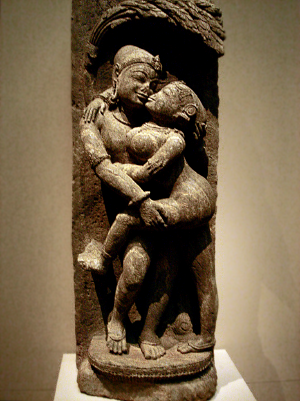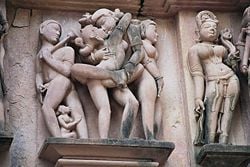Hieros gamos
Hieros Gamos (Greek ιερός γάμος, "sacred wedding") or Hierogamy refers to the coupling of a god and goddess or their earthly representatives, often having a symbolic meaning related to fertility and generally conducted in the spring.
The concept of the hieros gamos derives from ancient mythologies relating to the marriage of the first diety and his or her primary consort. In terms of the ritual expression of this idea, the heavenly marriage historically took three forms: the union of a god and goddess as expressed in various art forms; the union of a goddess and priest or king standing in the role of the god; and the union of a god and priestess standing for the goddess. The tradition of heiros gamos was usually performed in argricultural societies where these unions were understood to bring fertility to the land, especially in the Middle East.
The ritual sometimes, but not always, involved actual sexual intercourse. Although in some cultures it was shrouded in mystery, documented examples normally involved a public procession, an exchange of gifts, the purification of the couple enacted the ceremony, a wedding feast, the preparation of the marriage chamber; and an act of intercourse, either actual or symbolic. A festival on the following morning often celebrated the blessings brought to the community as a result: the union of heaven and earth resulting in the continuity of life's cycle of rain, fertility, procreation, and abudnance
Historical examples
Mesopatamia
In some cases, such as the "Sacred Marriage" of the king of a Sumerian city-state and the High Priestess of Inanna, it served a more practical purpose: since commoners frequently took this opportunity to have sex with their own spouses, it coordinated the births of children so that they would be born in the winter, when there was more time to take care of them. [1]
Hierogamy in the Hebrew Bible
Gnostic examples
In Tantric Yoga
Several sexual rituals are recommended and practised. These involve elaborate and meticulous preparatory and purificatory rites. The act balances energies coursing within the pranic ida and pingala channels in the subtle bodies of both participants. The sushumna nadi is awakened and kundalini rises upwards within it. This eventually culminates in samadhi wherein the respective individualities of each of the participants are completely dissolved in the unity of cosmic consciousness. Tantrics understand the act on multiple levels. The male and female participants are conjoined physically and represent Shiva and Shakti, the male and female principles. Beyond the physical, a subtle fusion of Shiva and Shakti energies takes place resulting in a united energy field. On an individual level, each participant experiences a fusion of their own Shiva and Shakti energies.
Modern examples
A possible modern example of hierogamy is in the religion of Wicca, in which participants engage in what is called the Great Rite. Most often done on Beltane night (May 1), a man and a woman, assuming the identities of God and Goddess, engage in sexual intercourse to celebrate the union of the deities as lovers and the conception of the new God who will be born at Yule. It is essentially a fertility rite, meant to symbolize the planting of seed into Mother Earth, which will come to fruition in the autumn.
It is furthermore one of the themes that Carl Jung dealt with, in his book Symbols of Transformation.
Influence
Hieros Gamos-like rituals provide controversial scenes in Stanley Kubrick's movie Eyes Wide Shut, in the novel Harvest Home by Tom Tryon and in the Dan Brown novel and Ron Howard film The Da Vinci Code.
See also
- Sex magic
- Tantra
- Religious prostitution
Notes
- ↑ [[Larry Gonick Gonick, Larry]] (1990). The Cartoon History of the Universe: From the Big Bang to Alexander the Great. Doubleday, 368. ISBN 0393324036.
ReferencesISBN links support NWE through referral fees
External links
- The Hierosgamos Theme in the Images of the Rosarium Philosophorum, Karen-Claire Voss
- Ivory statuette of hieros gamos (found at Delphi)
- Sculptural relief of hieros gamos from a temple to Hera in Sicily
- Sculptural relief of hieros gamos from Parthenon (temple of Athene) at Athens
- Wall-painting of hieros gamos from Roman period Pompeii
Credits
New World Encyclopedia writers and editors rewrote and completed the Wikipedia article in accordance with New World Encyclopedia standards. This article abides by terms of the Creative Commons CC-by-sa 3.0 License (CC-by-sa), which may be used and disseminated with proper attribution. Credit is due under the terms of this license that can reference both the New World Encyclopedia contributors and the selfless volunteer contributors of the Wikimedia Foundation. To cite this article click here for a list of acceptable citing formats.The history of earlier contributions by wikipedians is accessible to researchers here:
The history of this article since it was imported to New World Encyclopedia:
Note: Some restrictions may apply to use of individual images which are separately licensed.

